In most cases, acne on the cheeks in children is only a symptom of a specific disease. Acne in newborns is characterized by rapid resolution and moderate severity. Acne that occurs in children over one year of age occurs due to hormonal imbalance and hyperfunction of the sebaceous glands. In order to quickly and effectively get rid of acne, you need to seek help from a dermatologist.
Types of acne on the cheeks
There are many classifications of acne. Acne in children is completely different from acne in adults. Next, we’ll tell you about the types of acne on the cheeks in childhood:
Estrogenic acne occurs as a result of the influence of maternal hormones on the child's body. An excess of female sex hormones disrupts the normal functioning of the sebaceous glands. Neonatal acne occurs in a quarter of children in the first days of life. At the site of blockage of the sebaceous glands, whitish papules with a pearlescent tint are formed. The rash is localized on the cheeks, nose and genitals. In boys, estrogenic acne is more severe than in girls. A distinctive feature of newborn acne is the tendency to group the formed elements of acne. They are represented by closed comedones, papules, pustules and, in rare cases, nodules. This condition does not require special drug treatment. Acne acne goes away in the first three months of life, but sometimes this process can drag on for up to a year.
Unlike newborn acne, this type of rash occurs much later, at about 3-6 months of life. Their appearance is associated with an increase in the level of testosterone (male sex hormone) in the blood plasma. Hormonal disruption occurs due to temporary gonadotropic activation. Baby acne can last up to 4 years. If acne occurs in newborns, it is necessary to seek help from a pediatric dermatologist in order to exclude serious congenital diseases. Hyperplasia and tumor-like formations of the adrenal glands can masquerade as infant acne, so the occurrence of acne requires a thorough examination of the child. Infant acne often develops severe acne. Purulent cysts may appear followed by scarring. Acne is represented by open and closed pustules. Baby acne usually goes away by age two, but there are cases where acne can last up to 5 years. Acne can be complicated by spherical or conglobate acne. This form of the disease can lead to the development of severe acne during puberty.
In very rare cases, acne occurs over the age of one year and up to seven years; they are also called preschool acne. When acne appears in early childhood, you should pay attention to the level of neurophysical development. In some cases, preschool acne may only be a symptom of androgen-producing tumors or adrenal neoplasms.
Occurs in the age range from 7 to 12 years. Prepubertal acne is characterized by the appearance of open and closed comedomas on the face. In very rare cases, papules and pustules may occur. The appearance of these rash elements may indicate the presence of an endocrine disease. For example, polycystic ovary syndrome. If a girl develops acne before her first period appears, then she should seek help from an endocrinologist.
Occurs in boys and girls aged 12 to 16 years. Acne on the skin of the face appears in the form of typical acne lesions. However, juvenile acne is significantly different from adult acne, which occurs due to hormonal imbalance. During puberty, acne usually consists of papules and pustules, and to a lesser extent comedones.
Reasons for appearance
Rashes in the cheek area in children can occur for a variety of reasons. It is necessary to differentiate the pathological process from other dermatoses that can occur due to viral, fungal and bacterial diseases.
Acne of newborns occurs against the background of a sexual crisis, when a huge amount of maternal hormones enters the child’s body. Infant acne can occur due to poor diet by the mother. An allergic reaction to hygiene products (shampoo, soap, powder), indoor plants and animals is possible. All young children have not fully developed sebaceous and sweat glands. In addition, the newborn’s body has an immature thermoregulatory system. A sharp change in air temperature can trigger acne. Do not forget about infectious diseases, which manifest themselves in multiple rashes not only on the cheeks and throughout the body. You can suspect something wrong by an increase in body temperature and the presence of signs of a cold (runny nose, cough).
In adolescence, acne occurs due to a hormonal surge and poor personal hygiene. In order to avoid problems in the future, you need to visit a cosmetologist with your child, who will help you choose facial skin care products and teach them how to use them.
Diagnostics
If a child begins to develop acne between the ages of 1 and 12, you should consult a dermatologist. In order to assess the general condition of the body, the doctor prescribes routine tests, such as a clinical blood test and urine test. Metabolic processes can be assessed using a biochemical blood test. The occurrence of acne in this age range may indicate the development of a serious disease, where acne is only a symptom. The real reason may be inside the body. An imbalance of hormones leads to acne, so you need to seek help from an endocrinologist.
Acne in early childhood can cause hyperandrogenism. This disease manifests itself at early puberty. Boys develop body odor very early. Girls develop male pattern hair and develop a deep voice. To exclude the diagnosis of hyperandrogenemia, a study is prescribed to determine the levels of testosterone, follicle-stimulating and luteinizing hormone.
In addition to laboratory research methods, instrumental research methods are prescribed. Ultrasound diagnostics of the pelvic organs, kidneys and adrenal glands is carried out. If a malfunction of the hypothalamic-pituitary system is suspected, magnetic resonance imaging is recommended.
Drug therapy
The treatment of acne in childhood must be approached with the utmost seriousness. In addition to mental problems, acne can lead to serious pathological processes in the body. Self-medication is strictly prohibited. In a child’s body, all processes occur much faster than in an adult. Thus, small ulcers can quickly develop into a powerful inflammatory process. In addition, children's skin is significantly different from adult skin. Normally, a healthy child should not develop acne if the rules of personal hygiene are observed. When acne occurs, it is necessary to identify the root cause of the disease and eliminate the underlying disease. Next, we will discuss how acne is treated depending on age periods:
Estrogenic acne is characterized by a sudden appearance and rapid disappearance. They usually do not require special treatment. If multiple foci of acne appear, topical application of ketoconazole-based ointment is prescribed. The use of this substance will significantly reduce the period of rashes. If inflammation appears around the acne elements, they can be treated with a solution of aniline dye, such as blue or brilliant green.
The treatment for these types of acne is no different. Treatment of the severity of acne is treated with local preparations based on retinoids, benzyl peroxide and broad-spectrum antibacterial drugs. In very rare cases, antibiotics are prescribed in tablet form. An indication for antibiotics may be the appearance of deep nodes and papules that do not go away within 30 days. In this case, the drug of choice is erythromycin. If an allergic reaction occurs to the medicine, use sulfamethoxosil. For deep lesions of the skin of the cheeks, injections of triamcinolone acetonide or isotretinoin are indicated. The duration of treatment ranges from 6 to 12 months.
Treatment of acne in adolescence is carried out taking into account the form, location and concomitant diseases, if any. Topical comedolytics are more effective in the treatment of acne. This group includes drugs based on salicylic acid, retinoids, benzyl peroxide and retinoids. It should be noted that the use of scrubs and rough cosmetic procedures is contraindicated.
In the acute inflammatory period, the use of local antibacterial cosmetic products that contain benzoyl peroxide is indicated. Systemic antibiotic therapy is indicated in severe cases when local treatment is not effective. Dermatologists prescribe erythromycin, ampicillin or sulfamethoxazole. If a child develops nodular cystic and conglobate elements of acne on the facial skin, it is better to use isotretinoin. Its use reduces the risk of scarring.
When treating juvenile acne, you should pay special attention to hormonal levels. Severe and resistant forms of acne are treated with hormonal drugs, such as glucocorticosteroids and antiandrogens.
Procedures and traditional methods of treatment
It is prohibited to carry out cosmetic procedures to eliminate acne before reaching adulthood. It is necessary to treat traditional medicine with great caution. Alternative methods of treating acne can lead to irreparable harm to the child's health. Children are more susceptible to developing an allergic reaction than adults. It is allowed to wipe the face with decoctions of herbs that have antiseptic properties (chamomile, chamomile, calendula).
Prevention
When pimples appear, do not squeeze them. The child's face must be kept clean. Using all kinds of creams and oils can cause acne. Mothers of breastfed children must adhere to a special diet.
Conclusion
Acne is quite common in children. It is necessary to take very seriously the occurrence of acne at an atypical age (from 12 months to 8 years). If you experience prolonged or recurring acne, you should consult a dermatologist and related specialists. A quick diagnosis and timely treatment can prevent the formation of cosmetic defects and avoid psychological trauma to the child.
Necessary information for mothers on newborns and infants
Hello, dear readers! This article will be of particular interest to young parents and those who are still preparing to become parents. And we will talk about small pimples on your baby’s cheeks in the first month of life.
Agree, if you do not have the necessary information, it is easy to sound the alarm when you see some kind of rash on the face of a newborn baby. But don't panic. Now we will tell you why.
Reading Signals
Based on statistics, almost all newborn children have a rash. But there are different reasons and types. First you need to pay attention to the color of the pimples.
If they are white, then there is no particular cause for concern. Such rashes can be caused by residual maternal hormones in the newborn’s body or by the sebaceous glands not yet functioning properly. Gradually the rash will go away on its own. Of course, color alone is not enough. It is worth paying attention to the presence of itching, peeling and inflammation of the skin. If you have such symptoms, you should immediately consult a doctor.
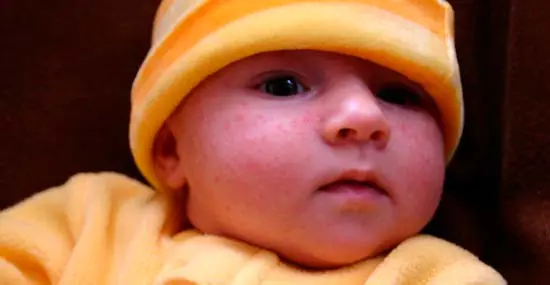
If you find red pimples on your baby’s body, neck or face, then you should be wary. Check immediately to see if he has a fever. If yes, then there is some kind of infection and an immediate visit to the pediatrician is required. It’s better not to delay this - a child’s body is not as strong as an adult’s.
If there is no temperature, you should pay attention to the following points:
- your diet over the past 24 hours;
- what kind of washing powder is used;
- does the child have problems with bowel movements;
- Is he sweating too much?
Sources of the problem
The most common causes of acne in infants are prickly heat, allergies, dysbacteriosis and infections.
Miliaria occurs most often due to excessive efforts of parents. The child should always be in a comfortable room temperature, regularly take air and sun baths and not overheat.
Clothes should be made of good, high-quality and natural material. The peculiarity of prickly heat is that it appears most often on the body, in places of natural folds and depressions.
Allergies usually manifest themselves on the face. It can be caused either by formula, if the baby is bottle-fed, or by food eaten by the nursing mother. During breastfeeding, mothers are especially advised to regularly record all the food they eat.
If you suspect an allergy in a child, you should pay attention to foods eaten approximately 18 hours ago. It is also worth paying attention to the products used for washing clothes with which the child comes into contact, the presence of dust, pollen, and animals. In children, all this causes a negative reaction much more easily than in an adult. If you suspect an allergy, we also strongly recommend that you consult a specialist.

Dysbacteriosis in a newborn occurs for completely natural reasons. As soon as they are born, children have completely sterile intestines. Gradually it is populated with normal microflora necessary for good digestion.
If your child has a stomach ache, is restless, screams, has bad, foul-smelling stools, is vomiting, or notices a white coating on the oral mucosa (called thrush), do not try to solve the problem yourself. This requires qualified help.
We have already written about infectious diseases above, so let’s now look at general recommendations for caring for children’s skin.
Recommendations
The first thing to note is that you should never try to squeeze your child’s pimples. They must go away on their own, otherwise you can damage your baby's skin with consequences that will last a lifetime.
- Under no circumstances should you treat the rash with alcohol or alcohol-containing solutions. And you need to be extremely careful with aqueous solutions.
- It is allowed to use a highly diluted solution of potassium permanganate. You can bathe your child in it. It is also useful to use a decoction of string or chamomile to treat acne or for baths.
- You need to wash your baby's face several times a day with boiled water, especially after feeding. Under no circumstances should you over-wrap him, use underwear and clothing only made from high-quality material.
- Use hypoallergenic powders for washing.
- Also keep a diary of the timing and content of your meals.
- Change your diaper promptly and bathe your baby every evening.
- A big plus would be adding a herbal decoction to the bath. And be sure to thoroughly wash off all products used to wash your child’s skin.
- Take sun and air baths - this is necessary to harden your child, develop immunity and prevent vitamin D deficiency.
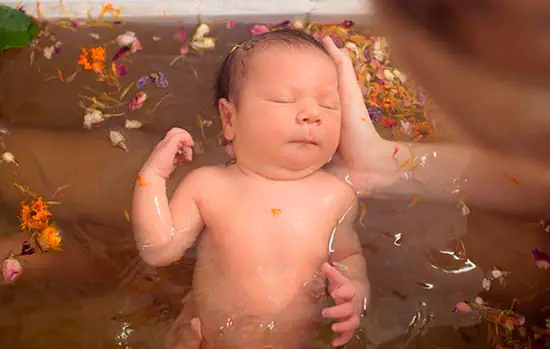
That's all the advice you need, dear readers. Take care of yourself and your children, because they are our future. Stay with us, don't forget to subscribe to news and share information with your friends and family. See you soon!
“Not a child, but blood and milk” - this is how they have been saying about strong men since ancient times, emphasizing a healthy complexion. Indeed, a light blush of a baby is most often an indicator of the normal functioning of the body and means that oxygen-enriched blood circulates freely, nourishing all systems and organs. But sometimes a child’s excessively red cheeks become a source of concern for loving parents, and for good reason. After all, the skin is one of the most sensitive indicators of deviations and failures occurring in the body. What are the reasons for the painful redness of a child’s tender cheeks?

Diathesis
The most common cause of red cheeks in a baby is diathesis. This is a special condition of the body, which indicates a predisposition to allergic, respiratory and inflammatory diseases. Most often it occurs in children from the first days of life to 3 years.
The newborn’s body is still just adapting to new living conditions. The baby is switching to a completely different nutritional system, so the work of his digestive organs is imperfect: the protective functions of the intestines have not yet been formed, digestive enzymes are not produced in the required quantities, and the permeability of the intestinal walls is increased. Foreign proteins, once in the child’s body, are not broken down and easily enter the bloodstream. The immune system reacts instantly by releasing antibodies that react with the allergens. As a result, excess histamine is released. This substance causes severe vasodilation (which is why red rashes appear on the cheeks), itching and swelling.
What signs will help determine allergic diathesis in an infant?
- Red, rough skin on the cheeks.
- Rashes in the form of small itchy blisters.
- Possibility of wet areas.
- Seborrheic crusts on the head.
- Abnormal stool.
- Nausea.
The impetus for the development of diathesis is the consumption of foods that can cause an allergic reaction:
- cow's milk - if you are intolerant to milk protein or lactose;
- Cereal porridge – for gluten allergies;
- fruits, vegetables and red berries;
- citrus fruits;
- nuts and especially peanuts;
- mushrooms;
- smoked meats;
- eggs;
- seafood.
- If diathesis appears in a breastfed child, then the nursing mother should carefully review her diet, excluding allergenic foods from it.
- Advice
- Baths or lotions based on a decoction of string or chamomile will help alleviate the baby’s condition and relieve redness and itching.
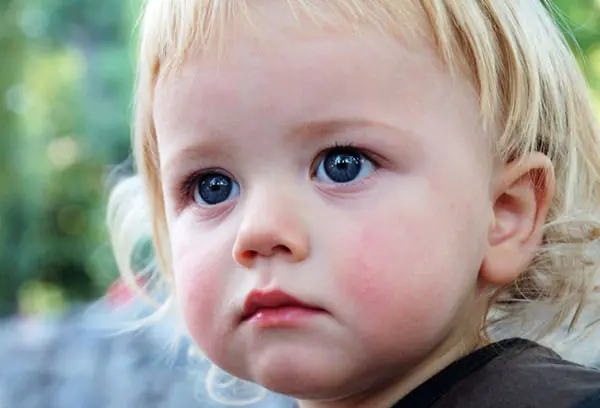
Allergy
A person has an excellent defense system - immunity. Immune cells fight foreign bodies with the help of produced antibodies. Sometimes, for some reason, the immune system malfunctions, and it begins to perceive pathogens that are harmless to health as hostile and produce antibodies to them. Among these numerous pathogens, the following should be particularly highlighted:
- plant pollen, especially during the flowering period;
- house dust;
- animal hair, down and feathers of birds;
- Food;
- medications - antibiotics, vaccines, drugs in the form of sweet syrups;
- chemical substances;
- poisonous substances that insects or reptiles inject into the bloodstream when they bite.
Allergy symptoms are very similar to symptoms of diathesis. The child appears:
- red spots on the cheeks that itch and peel;
- lacrimation, pain in the eyes and conjunctivitis;
- nasal congestion, sneezing and coughing;
- swelling;
- urticaria - a rash resembling blisters from a nettle burn;
- headache and malaise.
But if diathesis is a temporary condition that goes away as the functioning of the child’s body improves, then allergy is a pathology that often leads to serious consequences and requires treatment.
To eliminate allergy symptoms, including red cheeks in a child, the first step is to stop contact with the allergen. Lubricate the skin with baby cream or Bepanten regenerating ointment based on vitamin B5. Only a doctor should prescribe antihistamines!
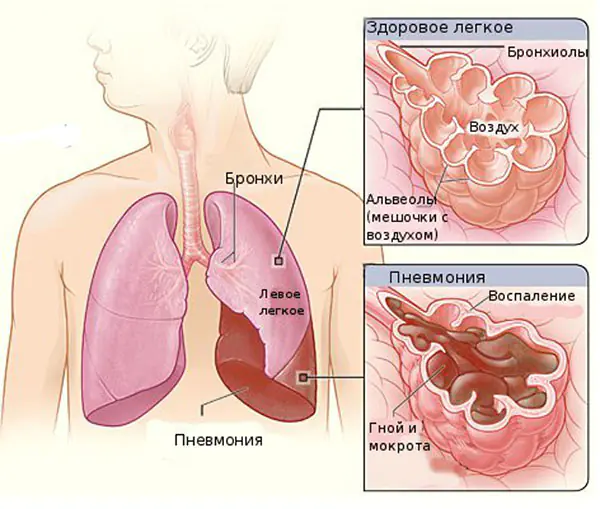
Pneumonia
Red cheeks against the background of unnaturally pale lips and the tip of the nose are a characteristic sign of pneumonia. This is a serious disease that is often diagnosed in children and poses a real threat to life. Therefore, every mother must know the typical manifestations of pneumonia:
- the child becomes lethargic and weak, refuses to play;
- loss of appetite;
- a very high temperature rises, which practically does not go down;
- shortness of breath and severe cough appear;
- The baby complains of body aches, nausea and headache.
If your child has such signs, you should not hesitate for a minute - immediately seek qualified medical help.
To avoid serious complications, treatment of a child with pneumonia should be carried out only in a hospital setting.
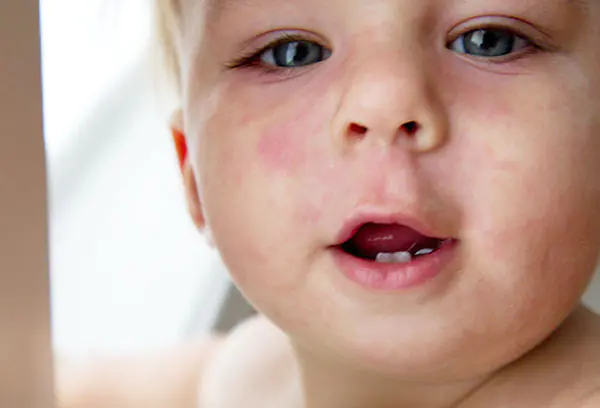
Roseola
The childhood infectious disease roseola is also accompanied by characteristic redness of the cheeks. A solid red spot, upon closer examination, turns out to be many small spots with jagged edges, located very close to each other. When pressed with a finger, the spot brightens and becomes pale pink. By this sign, roseola can be distinguished from rubella and allergic rashes on the skin of a child.
Skin manifestations occur in the second stage of the disease. They are preceded by classic symptoms of a viral infection:
- a sharp increase in temperature that lasts for 3 days (this is why roseola is also called three-day fever);
- weakness, lethargy, body aches appear;
- There is no cough or runny nose with this infection.
Roseola is treated in the same way as any other viral infection. A sick child needs to be provided with bed rest, plenty of fluids, and symptomatic therapy.
A complication of roseola in young children can be convulsions caused by very high temperatures. Therefore, parents need to constantly monitor the baby’s condition and give antipyretic drugs on time.

Worm infestations
A problem such as red cheeks in a child may appear due to helminthiasis - infection by parasites. The fact is that the baby’s body cannot fully resist helminthic infestations due to the imperfection of the immune system and the lack of a special digestive enzyme capable of destroying parasite larvae. They penetrate the children's body through:
- dirty hands;
- contaminated water;
- poorly washed vegetables and fruits;
- thermally unprocessed meat and fish;
- contact with animals.
Why do the baby’s cheeks turn red in this case? This is how the body reacts to toxic substances released during the life of parasites.
- Roundworms cause a hives-like rash—small red blisters that spread throughout the body and are intensely itchy.
- Pinworms – provoke the appearance of large, swollen red spots on the face.
- Giardia causes several types of rashes - from blisters similar to urticaria to complex dermatoses.
- Tapeworms lead to severe intoxication of the body, resulting in extensive skin rashes with scaly areas and skin fungus.
To these unpleasant manifestations of helminthic infestations are added such symptoms as itching in the anus, decreased appetite, weight loss, fatigue, pallor, and problems with the gastrointestinal tract.
TheRebenok.ru magazine recommends that for preventive purposes, children under 7 years old should be tested for worm eggs twice a year (in spring and late autumn).

Teething
At the age of 4 months, babies begin to erupt their first teeth. One of the signs of this rather painful process is the redness of the baby’s cheeks. There are several reasons for this.
- A few weeks before the appearance of the first tooth, the work of the salivary glands is activated - this is how the baby’s body prepares for the process of digesting solid food. The baby has not yet learned to swallow saliva, so it flows out, getting on the delicate skin of the cheeks and chin. Redness of the skin is the result of irritation caused by saliva.
- To appear on the surface, a baby tooth cuts through the gum, causing discomfort, swelling and inflammation. Children begin to intensively rub and scratch their cheeks, trying to relieve pain and, thereby, causing irritation and redness.
- Redness is explained by a rush of blood due to the dilation of blood vessels and small capillaries when body temperature rises.
Helping a baby in this condition involves eliminating the inflammatory process in the oral cavity and lowering body temperature. As soon as the tooth erupts, all symptoms will immediately disappear.
An ordinary teaspoon will help improve the condition when teething. Biting a cold metal surface will relieve pain and serve as a kind of massage for sore gums. It’s not for nothing that in the old days in Rus' it was customary to give babies silver spoons “for their teeth.”
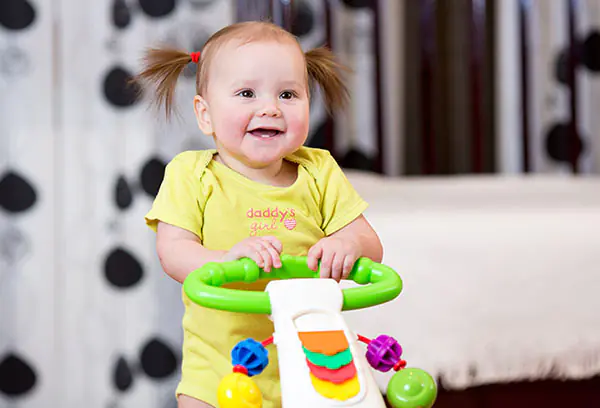
When there is no reason to worry
Don’t forget that a baby’s red cheeks are completely normal, especially if there are no other unpleasant or painful symptoms. After all, the surface layer of the skin, which is responsible for its opacity, is very thin in babies, and the smallest blood vessels - capillaries - shine through it, giving the cheeks a bright pink color.
Are your baby's cheeks red? This is a natural reaction of the body in the following cases.
- Exercise stress. To deliver more oxygen to working muscles, the heart begins to beat faster, increasing blood circulation in the body. The more intense the load, the redder the baby's cheeks will be.
- Long stay in the cold. Cold air greatly cools the skin of the cheeks. In response to this, the thermoregulation mechanism is activated, activating blood circulation in the capillaries to warm the frozen areas. This rush of blood causes redness. It is worth using a rich cream to protect your baby's skin from frostbite.
- Exposure to sunlight. When warmed, the subcutaneous capillaries expand and fill with blood.
- The child’s emotional reaction to some events is shame, anger, joy, embarrassment. The expansion of capillaries in such cases occurs under the influence of nerve impulses.
- Increased sensitivity of delicate baby skin, which reacts to any irritants - friction, saliva or food debris.
- Dry and hot air in the room. In such a situation, redness on the child’s cheeks and chin appears in the evening, and after bathing it goes away.
In such cases, the redness of the cheeks lasts for a maximum of several hours, and then disappears without a trace, without worsening the child’s well-being.
It is very important that there is always a sensitive, attentive and knowledgeable person next to the baby, who is able to spot alarming symptoms in time and provide the necessary help.



